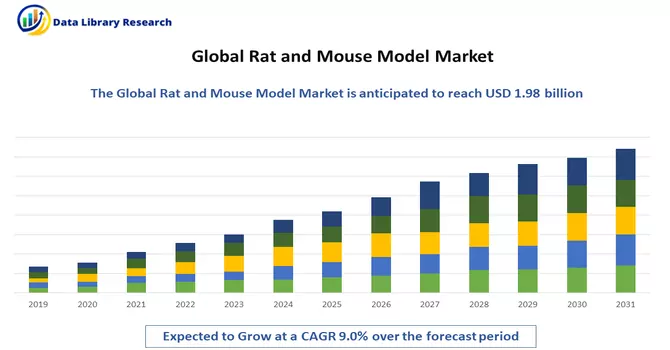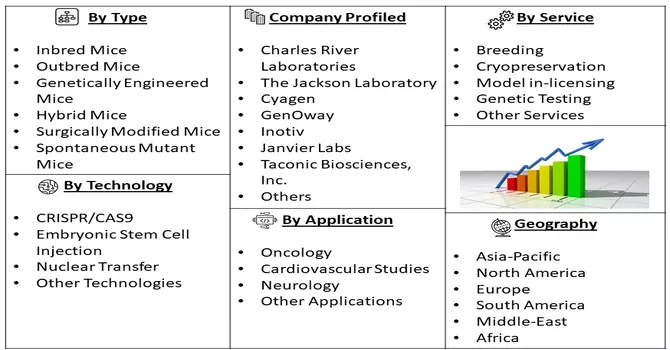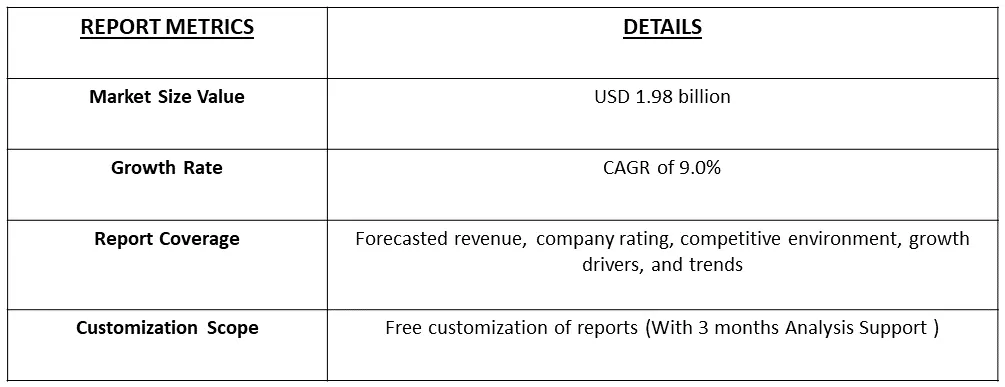The global market for rat and mouse models reached a valuation of USD 1.98 billion in 2023, and it is anticipated to exhibit a robust compound annual growth rate (CAGR) of 9.0% from 2024 to 2030.

Get Complete Analysis Of The Report - Download Free Sample PDF
Rat and mouse models are essential tools in biomedical research and preclinical studies, playing a crucial role in advancing our understanding of various biological processes, diseases, and potential treatments. Rats and mice share a high degree of genetic similarity with humans. Many genes associated with diseases in humans have counterparts in rodents, making these animals valuable for studying genetic factors underlying diseases. Also, rodents are commonly used in preclinical drug testing. The effects of potential drugs can be assessed in these animals before advancing to human clinical trials. This helps researchers identify promising candidates and understand potential side effects.
This growth is primarily driven by a heightened demand for genetically modified models, which play a crucial role in assisting researchers in the identification and validation of pharmaceutical targets. Additionally, the escalating research and development (R&D) expenditures within the pharmaceutical and biotechnology sectors are poised to further propel the expansion of this market. Rats and mice can be easily manipulated genetically, enabling researchers to create transgenic and knockout models. This genetic engineering capability allows the study of specific genes and their functions, helping researchers elucidate the molecular mechanisms underlying diseases.
Market Segmentation: The Rat and Mouse Model Market is Segmented by Type (Inbred Mice, Outbred Mice, Genetically Engineered Mice, Hybrid Mice, Surgically Modified Mice, and Spontaneous Mutant Mice), Service (Breeding, Cryopreservation, Model in-licensing, Genetic Testing, and Other Services), Technology (CRISPR/CAS9, Embryonic Stem Cell Injection, Nuclear Transfer, and Other Technologies), Application (Oncology, Cardiovascular Studies, Neurology, and Other Applications), and Geography (North America, Europe, Asia-Pacific, Middle East and Africa, and South America). The report offers the value (in USD million) for the above segments.

For Detailed Market Segmentation - Download Free Sample PDF
Market Drivers:
Increasing Innovation in Mouse and Rat Models and Rising Demand for Personalized Medicine
An article published in Molecular Neurodegeneration in June 2022 highlighted the significance of genetic engineering in creating novel mouse models using knock-in approaches to overcome the limitations associated with genetic mutations. The article concluded by emphasizing the importance of utilizing open-access mouse models as a valuable resource for studying disease-relevant biology. These developments are expected to contribute to an increased demand for mice models, consequently fostering growth in the market. Furthermore, the market is being driven by the growing demand for precision medicine. A publication in the journal Nature Medicine in April 2022 reported the rising use of genomic profiling for diagnosis and therapy guidance across various tumour types, leading to increased adoption of precision medicine in cancer patients. As the demand for precision medicine continues to rise, the utilization of mouse models is expected to follow suit, further propelling market growth.
Growing Pipeline of Pharmaceutical and Biopharmaceutical Companies
The growing pipeline of pharmaceutical and biopharmaceutical companies is closely intertwined with the utilization of mouse models in preclinical research and drug development. This symbiotic relationship is driven by several key factors that underscore the importance of mouse models in advancing the pharmaceutical and biopharmaceutical industries. Mouse models serve as indispensable tools in the drug discovery and development process. Pharmaceutical and biopharmaceutical companies leverage these models to assess the efficacy and safety of new drug candidates before advancing to human clinical trials. The ability to mimic human physiological responses in mice provides valuable insights into potential drug outcomes. Also, collaboration between pharmaceutical and biopharmaceutical companies and research institutions that specialize in mouse model development is becoming more prevalent. These collaborations enhance access to diverse and specialized mouse models, fostering innovation in preclinical research.
Market Restraints:
Regulations for the Ethical Use of Animals
Regulations for the ethical use of animals are critical to ensure that scientific research and testing involving animals are conducted responsibly and with the highest standards of animal welfare. Ethical considerations and guidelines aim to strike a balance between advancing scientific knowledge and protecting the well-being of animals involved in research. Many countries have specific legal frameworks governing the ethical use of animals in research. These frameworks define the responsibilities of researchers, institutions, and oversight bodies, outlining the consequences of non-compliance. Thus, struct regulations for the use of mouse may impact the growth of the studied market over the forecast period.
The market faced substantial disruptions during the COVID-19 pandemic, with notable impacts on research laboratories and the biopharmaceutical industry, both of which extensively relied on mice models for preclinical development. An article published in October 2022 in Methods of Molecular Biology highlighted the utilization of a small rodent animal model, specifically K18 hACE2 transgenic mice, as an option for comprehending the pathogenicity of natural SARS-CoV-2 strains. This model played a crucial role in addressing Variants of Concern (VoC) and contributed to the identification and characterization of prophylactic (vaccine) and therapeutic (antiviral and neutralizing monoclonal antibodies) strategies for preventing or treating SARS-CoV-2 infection and its associated COVID-19 disease. The adoption of mouse models to assess progress in developing and applying relevant models for SARS-CoV-2 had been anticipated to drive market growth during the pandemic. However, as the number of COVID-19 cases began to decline, the market gradually returned to average pre-pandemic growth levels. Despite this initial impact, the market is poised to maintain a significant growth trajectory during the forecast period.
Segmental Analysis:
Genetically Engineered Mice Segment is Expected to Witness Significant Growth Over the Forecast Period
Genetically engineered mice are designed with specific alterations to their genetic makeup, allowing researchers to study the function of genes and their role in various biological processes. These mice serve as valuable tools for modelling human diseases, understanding gene functions, and testing potential therapies. The rat and mouse model market thrives on the demand for genetically engineered mice tailored to specific research needs. Biomedical researchers often require customized mouse models with specific gene mutations, knock-ins, or knockouts to mimic human diseases accurately. The rat and mouse model market experiences growth driven by the increasing adoption of genetically engineered mice in research. Industry collaborations between biotechnology companies, research institutions, and mouse model providers contribute to the development and accessibility of innovative mouse models. Thus, the interplay between genetically engineered mice and the rat and mouse model market is dynamic and symbiotic. The demand for precise, customized mouse models to advance biomedical research fuels innovation in genetic engineering technologies, fostering growth in the market and contributing to breakthroughs in understanding and treating various diseases.
Model in-licensing Segment is Expected to Witness Significant Growth Over the Forecast Period
Model in-licensing plays a strategic role in the dynamic and evolving landscape of the mouse and rat model market. In-licensing refers to the process of obtaining external models or technologies through agreements, partnerships, or licenses. Model in-licensing allows companies in the mouse and rat model market to diversify their offerings. By acquiring external models through licensing agreements, market players can expand their portfolio to include a broader range of genetically engineered mice and rats with specific genetic modifications or characteristics. In-licensing allows companies to expand their global presence by accessing models developed by international research institutions or organizations. This global collaboration enhances the diversity and applicability of models in different regions, contributing to the expansion of the mouse and rat model market. Thus, owing to such advantages, the segment is expected to witness significant growth over the forecast period.
CRISPR/CAS9 Segment is Expected to Witness Significant Growth Over the Forecast Period
The integration of CRISPR/Cas9 technology has revolutionized the landscape of the mouse and rat model market, offering unprecedented precision and efficiency in genetic engineering. CRISPR/Cas9 is celebrated for its exceptional precision in genetic modification. This technology allows researchers in the mouse and rat model market to precisely edit or alter specific genes, facilitating the creation of models with targeted mutations, insertions, or deletions. The efficiency of CRISPR/Cas9 in genome editing significantly expedites the process of creating genetically engineered mouse and rat models. Compared to traditional methods, CRISPR/Cas9 enables researchers to achieve desired genetic modifications with greater speed and accuracy. Thus, the integration of CRISPR/Cas9 technology has redefined the possibilities and capabilities within the mouse and rat model market. This revolutionary tool empowers researchers to conduct more precise, efficient, and diverse genetic engineering, fostering breakthroughs in scientific research, disease modelling, and drug discovery.
The Oncology Segment is Expected to Witness Significant Growth Over the Forecast Period
The intersection of oncology research and mouse/rat models has played a pivotal role in advancing our understanding of cancer biology, facilitating drug development, and providing valuable insights into personalized medicine. Mouse and rat models have been instrumental in studying the intricate biology of tumours and their microenvironments. These models allow researchers to simulate and analyze the complex interactions between cancer cells, immune cells, and the surrounding tissues, providing a holistic view of tumour behaviour. Genetically engineered mouse models (GEMMs) enable the study of cancer initiation and progression by introducing specific genetic alterations that mirror those observed in human cancers. These models closely mimic the stepwise development of tumours, aiding in the identification of key molecular events. Thus, mouse and rat models serve as indispensable tools in advancing oncology research. Their contribution spans a wide range of applications, from elucidating tumour biology to evaluating therapeutic strategies. As technology continues to evolve, these models will play a central role in shaping the future of cancer research and treatment.
North America Region is Expected to Witness Significant Growth Over the Forecast Period
North America is poised for growth throughout the forecast period, driven by heightened healthcare spending, expanded research and development initiatives, and an escalating incidence of infectious and non-communicable diseases. Market entities within the region are actively engaged in various endeavours, including collaborations and agreements, which are expected to propel market expansion in the foreseeable future. For example, in May 2021, the SDS Alliance initiated a Mouse Model Project in collaboration with the Jackson Laboratory. This initiative aims to develop a mouse model by introducing SDS disease genes into mice using CRISPR technology, with subsequent breeding, for a total cost of USD 150,000. The project also involves characterizing the model to understand how SDS presents in mice compared to human SDS, examining whether the mice develop pancreatic problems or neutropenia, among other aspects, for an additional USD 150,000.
Furthermore, in November 2021, Tranquil Therapeutics, a private immuno-neurology company, unveiled positive preclinical data on its lead program, TQS-168, at the Neuroscience 2021 meeting. The data showcased the potential of TQS-168 in treating amyotrophic lateral sclerosis (ALS). In a widely used SOD1-G93A transgenic mouse model, TQS-168 demonstrated increased median survival and reduced pro-inflammatory cytokines and inflammatory monocytes. The compound also exhibited a similar decrease in inflammatory monocytes in the blood of ALS patients. Such advancements in the region are anticipated to contribute significantly to market growth.

Get Complete Analysis Of The Report - Download Free Sample PDF
The market for mice models exhibits a moderate level of concentration, characterized by the presence of companies that operate on both a global and regional scale. This diversity in the market landscape signifies the participation of entities with varying scopes and reach, contributing to the overall dynamics of the industry. The competitive environment encompasses players that operate across different geographical boundaries as well as those focusing on specific regional markets. This mix of global and regional participants creates a nuanced and competitive market scenario, fostering a dynamic interplay of factors within the mice model industry. Key Rat and Mouse Model Companies:
Recent Development:
1) In May 2023, Taconic Biosciences, a prominent player in biotechnology known for offering a diverse range of mice models, unveiled a novel addition to the FcResolv NOG Portfolio. This new model is designed to facilitate the sustained engraftment of human lymphoid cells.
2) In February 2023, Ozgene, a provider specializing in genetically customized mice for researchers, was chosen by the Animal Resources Centre (ARC) to take over its operations in Australia. This initiative positions Ozgene as the provider for mouse and rat lines in Western Australia.
Q1. What was the Rat and Mouse Model Market size in 2023?
As per Data Library Research the global market for rat and mouse models reached a valuation of USD 1.98 billion in 2023.
Q2. What is the Growth Rate of the Rat and Mouse Model Market?
Rat and Mouse Model Market is anticipated to exhibit a robust compound annual growth rate (CAGR) of 9.0% over the forecast period.
Q3. Which region has the largest share of the Rat and Mouse Model market? What are the largest region's market size and growth rate?
North America has the largest share of the market. For detailed insights on the largest region's market size and growth rate request a sample here.
Q4. Who are the key players in Rat and Mouse Model Market?
Some key players operating in the market include
Data Library Research are conducted by industry experts who offer insight on industry structure, market segmentations technology assessment and competitive landscape (CL), and penetration, as well as on emerging trends. Their analysis is based on primary interviews (~ 80%) and secondary research (~ 20%) as well as years of professional expertise in their respective industries. Adding to this, by analysing historical trends and current market positions, our analysts predict where the market will be headed for the next five years. Furthermore, the varying trends of segment & categories geographically presented are also studied and the estimated based on the primary & secondary research.
In this particular report from the supply side Data Library Research has conducted primary surveys (interviews) with the key level executives (VP, CEO’s, Marketing Director, Business Development Manager and SOFT) of the companies that active & prominent as well as the midsized organization
FIGURE 1: DLR RESEARH PROCESS

Extensive primary research was conducted to gain a deeper insight of the market and industry performance. The analysis is based on both primary and secondary research as well as years of professional expertise in the respective industries.
In addition to analysing current and historical trends, our analysts predict where the market is headed over the next five years.
It varies by segment for these categories geographically presented in the list of market tables. Speaking about this particular report we have conducted primary surveys (interviews) with the key level executives (VP, CEO’s, Marketing Director, Business Development Manager and many more) of the major players active in the market.
Secondary ResearchSecondary research was mainly used to collect and identify information useful for the extensive, technical, market-oriented, and Friend’s study of the Global Extra Neutral Alcohol. It was also used to obtain key information about major players, market classification and segmentation according to the industry trends, geographical markets, and developments related to the market and technology perspectives. For this study, analysts have gathered information from various credible sources, such as annual reports, sec filings, journals, white papers, SOFT presentations, and company web sites.
Market Size EstimationBoth, top-down and bottom-up approaches were used to estimate and validate the size of the Global market and to estimate the size of various other dependent submarkets in the overall Extra Neutral Alcohol. The key players in the market were identified through secondary research and their market contributions in the respective geographies were determined through primary and secondary research.
Forecast Model
